The world is filled with countless creatures, but few are as impressive as the swift birds that rule the skies. These fearless creatures are famously recognized for their amazing speed and sharp instincts. These birds are some of the most daunting predators in the animal kingdom.
The excitement of watching these regal creatures in their habitat is a rare treat for nature lovers and bird enthusiasts. But which of these magnificent birds are the fastest in the United States? And where you can witness their impressive speed in action? In this article, we’ll look at these incredible speedsters of American skies.
10. Common Eider (Somateria mollissima) – 70 mph
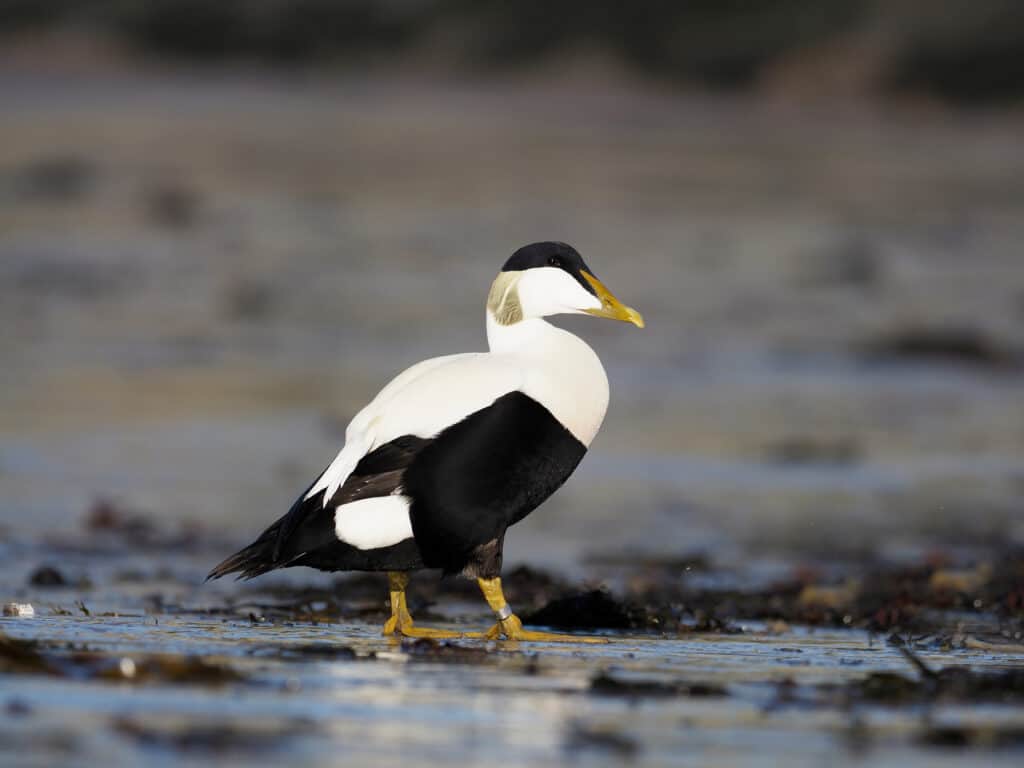
The diet of these birds includes crustaceans, mollusks, marine worms, fish eggs, and sea urchins.
©Erni/Shutterstock.com
The common eider is a remarkable sea duck, easily identifiable by its striking appearance. Breeding males have white and black feathers, a black cap, a pale green nape, and a green to yellow-orange bill. Nonbreeding and immature males are brown with white patches. Females have warm brown feathers with black barring and a black bill.
The diet of these birds includes crustaceans, mollusks, and echinoderms like marine worms, fish eggs, and sea urchins. They particularly enjoy blue mussels, which they extract from underwater rocks using their chisel-like bills.
They possess high-speed wings that enable them to fly in compact flocks of thousands, skimming low over the water’s surface. With a remarkable speed of up to 70 mph, this species is recognized as one of the fastest ducks.
Where Can You Find Common Eider?
Sightings of common eiders are rare since they are mostly found along the coasts of Alaska and New England. However, occasional sightings are as far south as New Jersey. They are also rare visitors to South Carolina. The breeding season sees these ducks nesting on coastal islands, islets, and narrow points of low-lying land.
9. Canvasback (Aythya valisineria) – 72 mph
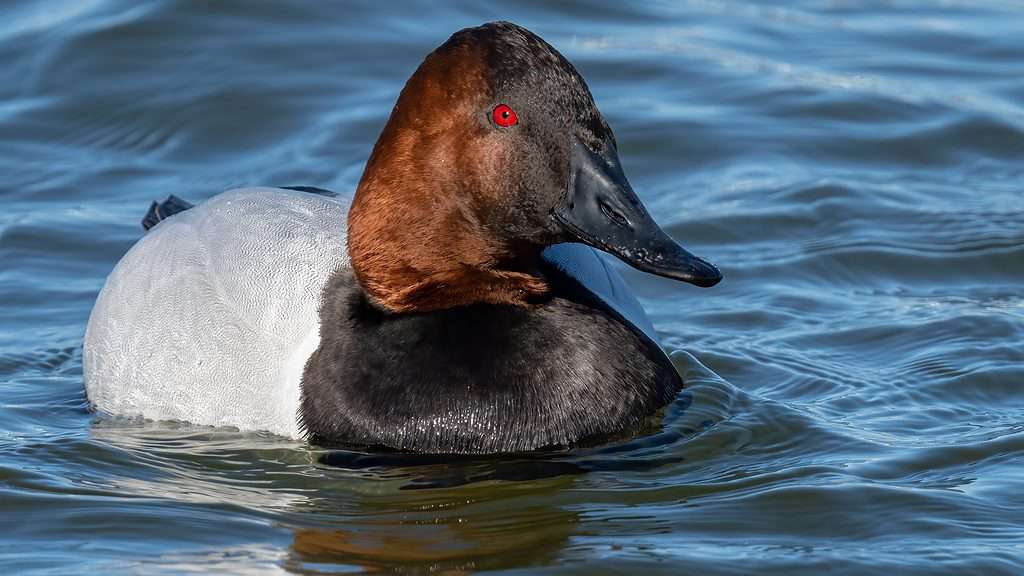
Being omnivorous, these ducks consume a number of food sources, such as seeds, plant tubers, mussels, and insects.
©Krumpelman Photography/Shutterstock.com
The largest diving duck in North America, the canvasback, is just ahead of the common eider when it comes to speed. With its striking appearance, the canvasback is easily recognizable due to its long, dark bill that slopes into the head. Females have a whitish body, a brownish tail, and a brownish head and chest. A black breast, a rusty red head and neck, a black tail, and a white body characterize males.
Being omnivorous, these ducks consume a number of food sources, such as seeds, plant tubers, mussels, and insects.
The canvasback’s takeoff is a sight to behold as it runs across the water’s surface before taking flight. This one-of-a-kind duck boasts impressive flying capabilities. It reaches speeds of up to 72 miles per hour in the air, thanks to its high-speed wings.
Where Can You Find Canvasback?
This migratory bird spends winter in the United States, traveling along the Mississippi and Pacific Flyways to its wintering grounds. The Mississippi Flyway leads to the Mid-Atlantic and Lower Mississippi Valley. The Pacific Flyway takes them to the California coast. They are frequently observed on the Texas coast from November to March, inhabiting various bodies of water and surrounding uplands.
8. Red-Breasted Merganser (Mergus serrator) – 80 mph
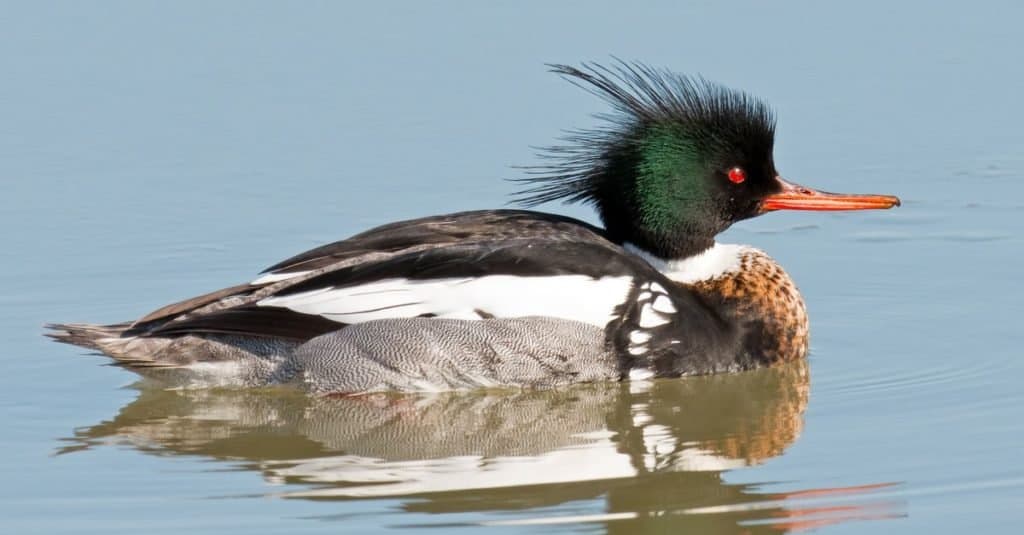
These funny-looking birds exhibit a distinct appearance, featuring a cinnamon-colored chest, a white neck band, and a fuzzy green head.
©Brian E Kushner/Shutterstock.com
Red-breasted mergansers exhibit a distinct appearance, featuring a cinnamon-colored chest, a white neck band, and a fuzzy green head during the breeding season. Non-breeding males and females have a brownish-gray coloration with a brownish chin, dingy breasts, and a brown fuzzy head. In flight, both sexes can be distinguished by a prominent white lower-wing panel.
Their diet mainly consists of small fish, not over 6 inches long. However, they also feed on insects, tadpoles, and crustaceans occasionally.
This bird holds the record for the fastest recorded speed by a duck. One merganser reached an impressive 80 miles per hour in flight while being chased by an airplane. Their ability to fly so fast is partly due to their high-aspect-ratio wings, which also contribute to their remarkable agility.
Where Can You Find Red-Breasted Merganser?
Red-breasted mergansers breed in boreal forests near coastal freshwater, brackish, and saltwater wetlands. During migration and wintering, they can be found in oceans, lakes, and rivers across the United States. They are commonly observed in coastal waters during winter, making this season the ideal time for birdwatching.
7. Eurasian Hobby (Falco subbuteo) – 100 mph
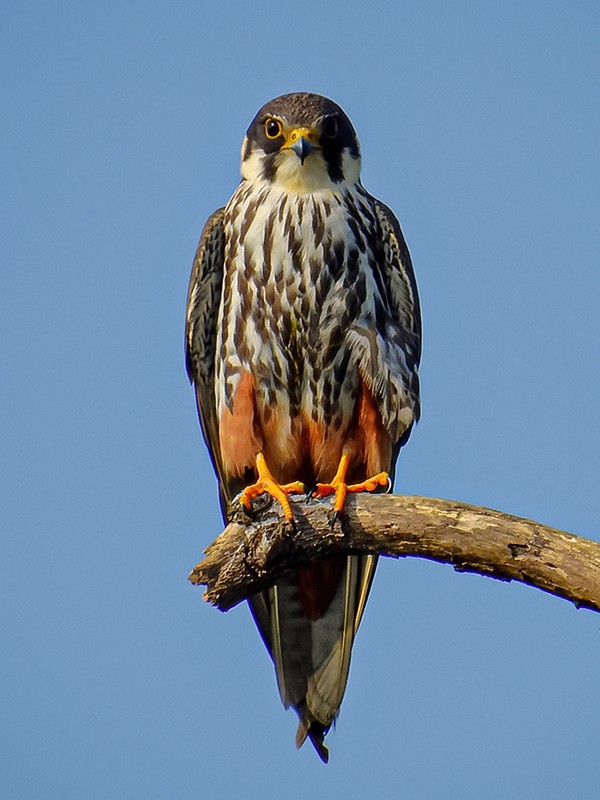
Thanks to their streamlined bodies, Eurasian hobbies can reach speeds of up to 100 mph.
©Shantanu Kuveskar / CC BY-SA 4.0 – License
The Eurasian hobby is a slender and small falcon. It is characterized by slate-gray feathers on its upper body, two short black moustachial stripes, and a dark crown. Its throat is unstreaked and white, while the thighs and the undertail are rufous, a reddish-brown color. The remainder of the underparts is white with black streaks.
The Eurasian hobby’s diet primarily consists of insects, particularly flying insects which it consumes while in flight. During the breeding season, it also feeds on small birds.
Thanks to their streamlined bodies and long, pointed wings, Eurasian hobbies can reach incredible speeds of up to 100 mph while pursuing prey. Their aerodynamic build enables them to fly swiftly and efficiently while pursuing their target.
Where Can You Find Eurasian Hobby?
The Eurasian hobby is not common in the country. However, locals have spotted them in Alaska, the northeast (south to Massachusetts), and the northwest (south to Washington). This species inhabits open areas with some trees, like forests, open woodlands, or river edges.
6. Bald Eagle (Haliaeetus leucocephalus) – 100 mph
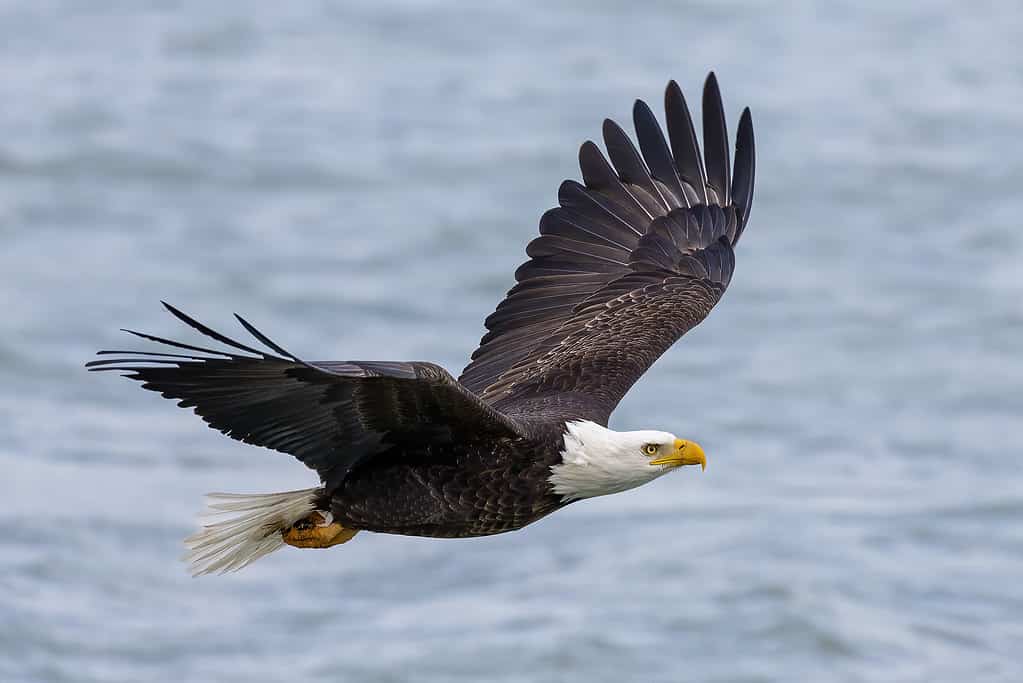
These birds of prey are opportunistic hunters, adapting their diet to the available food sources in their habitat.
©iStock.com/Karel Bock
Bald eagles do not need an introduction. They are one of the most famous birds in North America. Fully-grown bald eagles feature dark brown bodies and wings, accompanied by white heads and tails. These striking birds are easily distinguishable by their bright yellow legs and bills, adding to their striking appearance.
Bald eagles are not picky eaters. Their diet primarily consists of turtles, snakes, waterfowl, rabbits, and other small animals, as well as carrion. These birds of prey are opportunistic hunters, adapting their diet to the available food sources in their habitat.
When diving for prey, the bald eagle utilizes the wind to its advantage, angling its head, wings, and tail to achieve maximum speed. With the wind at their back, they are capable of diving at speeds of up to 100 miles per hour.
Where Can You Find Bald Eagle?
Bald eagles live pretty much everywhere in the United States, with Alaska having the largest population. These birds usually reside in areas close to significant bodies of open water that provide them with sufficient food. Additionally, they nest in old-growth trees.
5. Red-Tailed Hawk (Buteo jamaicensis) – 120 mph
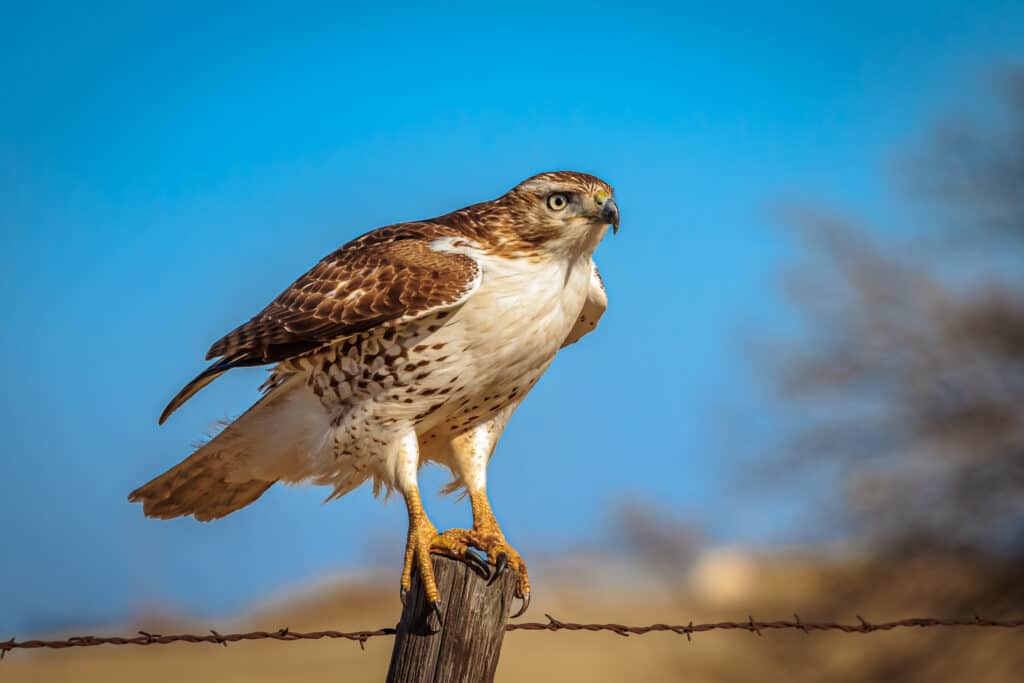
While red-tailed hawks may not be the fastest in ordinary flight, they are incredibly fast divers.
©Richard G Smith/Shutterstock.com
The red-tailed hawk is the most common and widespread large hawk species in North America. These hawks are typically rich brown on their upper bodies and pale on their undersides. They also have a streaked belly and a dark bar between the shoulder and wrist on the underside of their wings. Their tails are usually cinnamon-red above and pale below.
Mammals comprise a significant portion of these hawks’ diet, including mice, rabbits, and hares. Additionally, they feed on medium-sized birds and reptiles, such as lizards and snakes.
While red-tailed hawks may not be the fastest in ordinary flight, they are incredibly fast divers. When swooping down to catch prey, which they can spot from up to 100 feet away, these hawks can reach remarkable speeds of at least 120 miles per hour.
Where Can You Find Red-Tailed Hawk?
These hawks breed throughout most of North America and live in various terrains that offer open ground for hunting and high perches for nesting. Their habitats may range from woodlands with scattered clearings to open grasslands.
4. Gyrfalcon (Falco rusticolus) – 130 mph
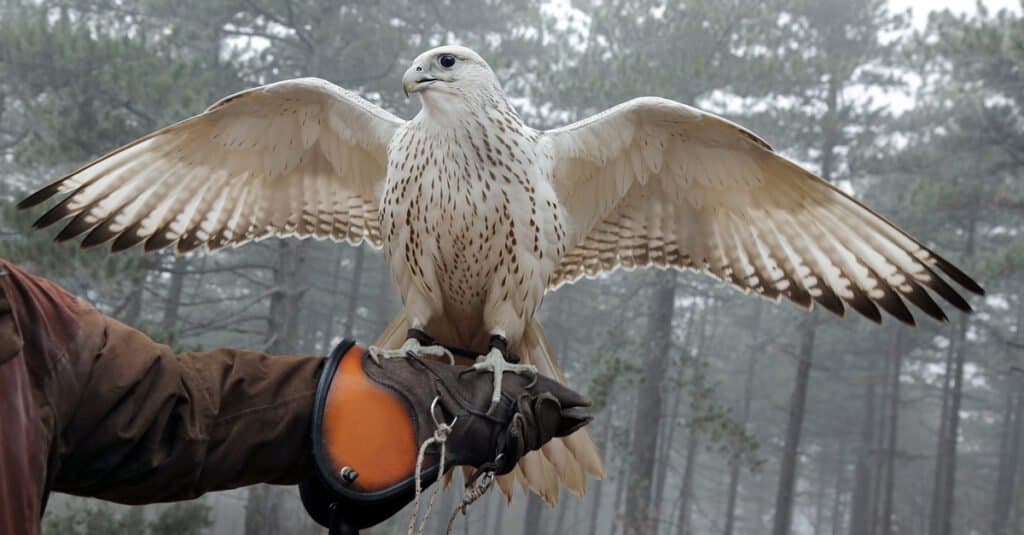
Their long tail and thick, powerful body, particularly in females, make them formidable predators.
©Selena_ Q/Shutterstock.com
Gyrfalcons, the world’s largest falcons, have pointed wings, although not as narrow or pointed as those of smaller falcons. Their long tail and thick, powerful body, particularly in females, make them formidable predators. Although the iconic image of a gyrfalcon might depict a white bird with black spots, these birds actually come in various colors. This includes shades of grey, white, and dark brown.
Gyrfalcons primarily hunt and consume mammals but also feed on birds, making them versatile predators.
They are one of the fastest falcon species worldwide. When diving in pursuit of prey, these birds are capable of reaching incredibly high speeds of up to 130 mph.
Where Can You Find Gyrfalcon?
Spotting a gyrfalcon is not easy since they mostly reside in the northernmost regions of the United States. Birdwatchers should look for gyrfalcon near open water with plenty of waterfowl.
3. Ferruginous Hawk (Buteo regalis) – 150mph
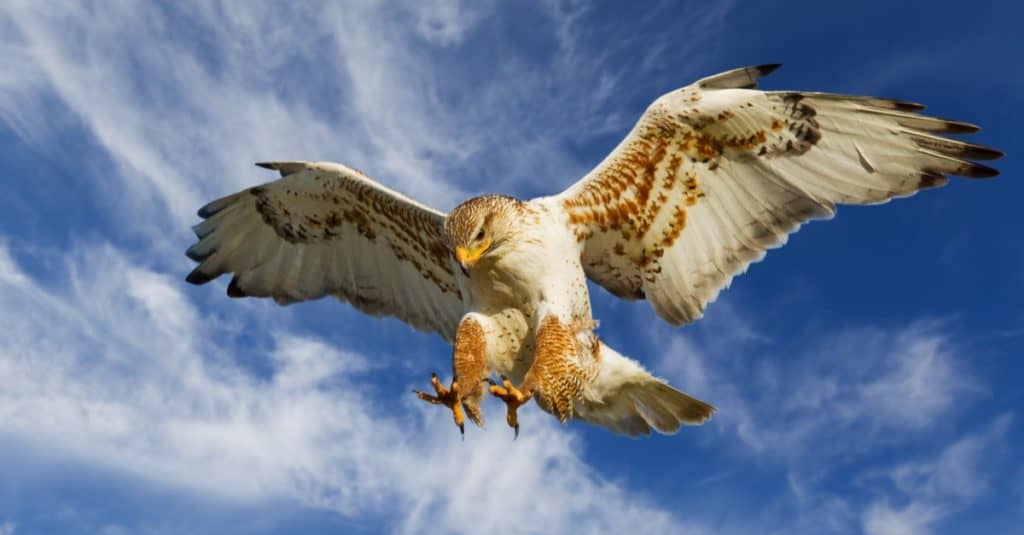
With its rich rusty shoulders and legs, gleaming white underparts, and gray head, this bird boasts a striking combination of colors.
©Stephen Mcsweeny/Shutterstock.com
The ferruginous hawk is among the largest hawks in the world and has a unique appearance. With its rich rusty shoulders and legs, gleaming white underparts, and gray head, this bird boasts a striking combination of colors. The dark-morph ferruginous hawk, which is rarer, displays a reddish-chocolate hue, further adding to its unique beauty.
These birds prey on small animals like jackrabbits, ground squirrels, mice, birds, snakes, and large insects available to them.
Due to its fast and agile flight, the ferruginous hawk is a highly effective hunter compared to other large bird species. Like eagles, it flaps its wings slowly but can still reach a fantastic speed of up to 150 mph when diving.
Where Can You Find Ferruginous Hawk?
The ferruginous hawk only lives in North America, where it resides in the Western United States and Southwestern Canada. This bird of prey prefers to inhabit arid and open landscapes such as sagebrush areas, deserts with short vegetation, and short-grass prairies.
2. Golden Eagle (Aquila chrysaetos) – 200 mph
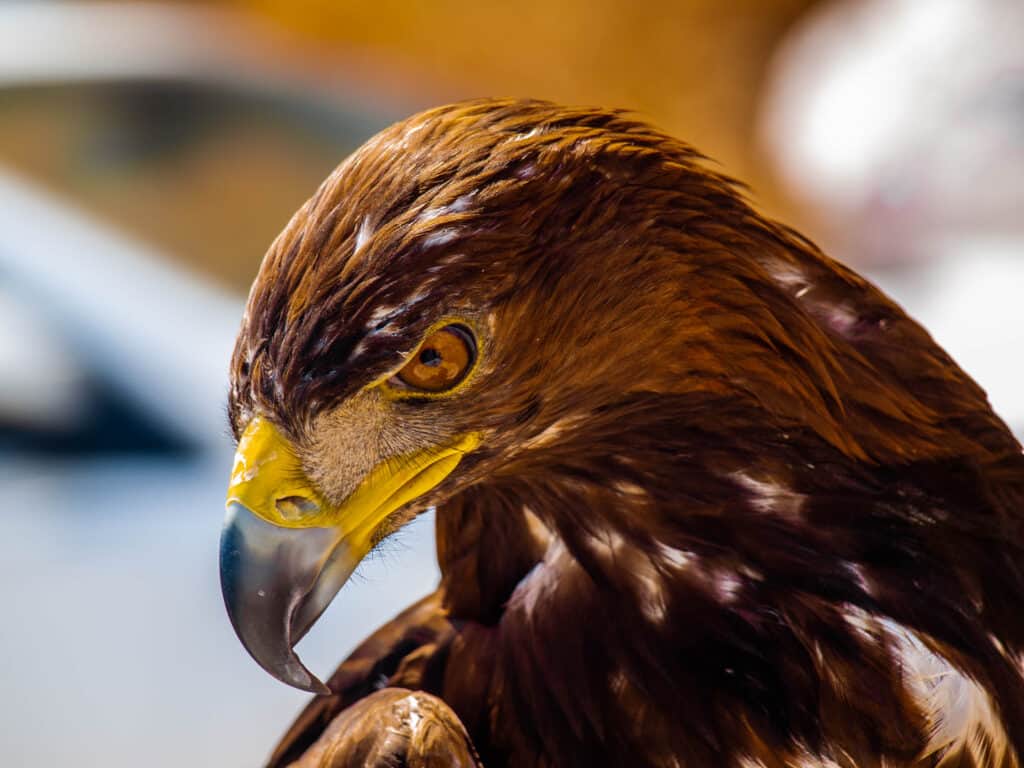
These eagles have dark brown plumage with white markings at the base of their tails and golden feathers on the backs of their heads.
©elmehdi.ph/Shutterstock.com
One of the fastest, most agile, and largest birds of prey in North America is the famous golden eagle. These eagles have dark brown plumage with white markings at the base of their tails and golden feathers on the backs of their heads. Their bills and talons are black, which adds to their distinctive appearance.
These eagles’ diet primarily consists of live and carrion mammals and birds.
Golden eagles display impressive diving speed when pursuing prey and can reach extraordinary speeds of up to 200 mph. These birds of prey have aerodynamic bodies and significant wingspans that allow them to sustain these high speeds during a dive.
Where Can You Find Golden Eagle?
Golden eagles live everywhere in the United States. In North America, they are present from Alaska to Northern Mexico and inhabit a diverse range of open landscapes, including shrubsteppes, shortgrass prairies, and other grassland habitats.
1. Peregrine Falcon (Falco peregrinus) – 242mph
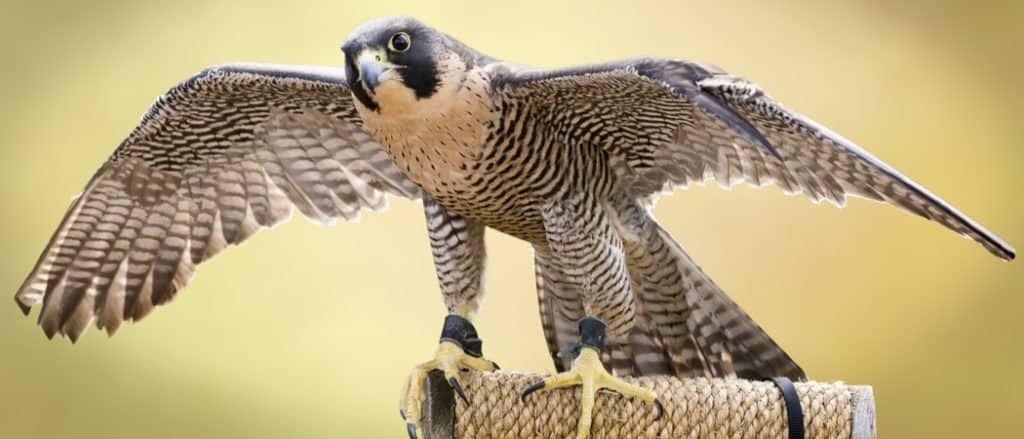
They have blue-gray plumage above, with a blackish head and an evident black “mustache” that stands out against their white face.
©Michael Shake/Shutterstock.com
The peregrine falcon is not only the fastest bird but also the fastest animal on the planet. These powerful and large falcons possess a relatively short tail and long, broad, pointed wings. They have blue-gray plumage above, with a blackish head and an evident black “mustache” that stands out against their white face. Their breast has fine bars.
The primary source of food for peregrine falcons is other birds, which they skillfully capture while in flight.
These falcons possess a large keel, allowing more muscle attachment and generating more flapping power. Their pointed wings, which are swept back and contribute to their streamlined figure, are also crucial to their ability to reach mind-boggling speeds. Additionally, they are lightweight, aerodynamically shaped, and possess robust respiratory systems, all of which enable them to be the fastest birds, capable of reaching speeds of up to 242 mph!
Where Can You Find Peregrine Falcon?
Peregrine falcons have remarkable adaptability and reside in an extensive range of habitats, from sea level to altitudes exceeding 10,000 ft. They inhabit various landscapes, including dry deserts and high rainfall areas, spanning from the equator to the Arctic Circle.
These falcons are prevalent throughout the year on the west coast, from Washington to California and westward into Arizona, Western Texas, and New Mexico. Additionally, there is a permanent resident population of peregrine falcons in the eastern region of North America, ranging from North Carolina to New York State.
The photo featured at the top of this post is © Al Carrera/Shutterstock.com
Thank you for reading! Have some feedback for us? Contact the AZ Animals editorial team.






